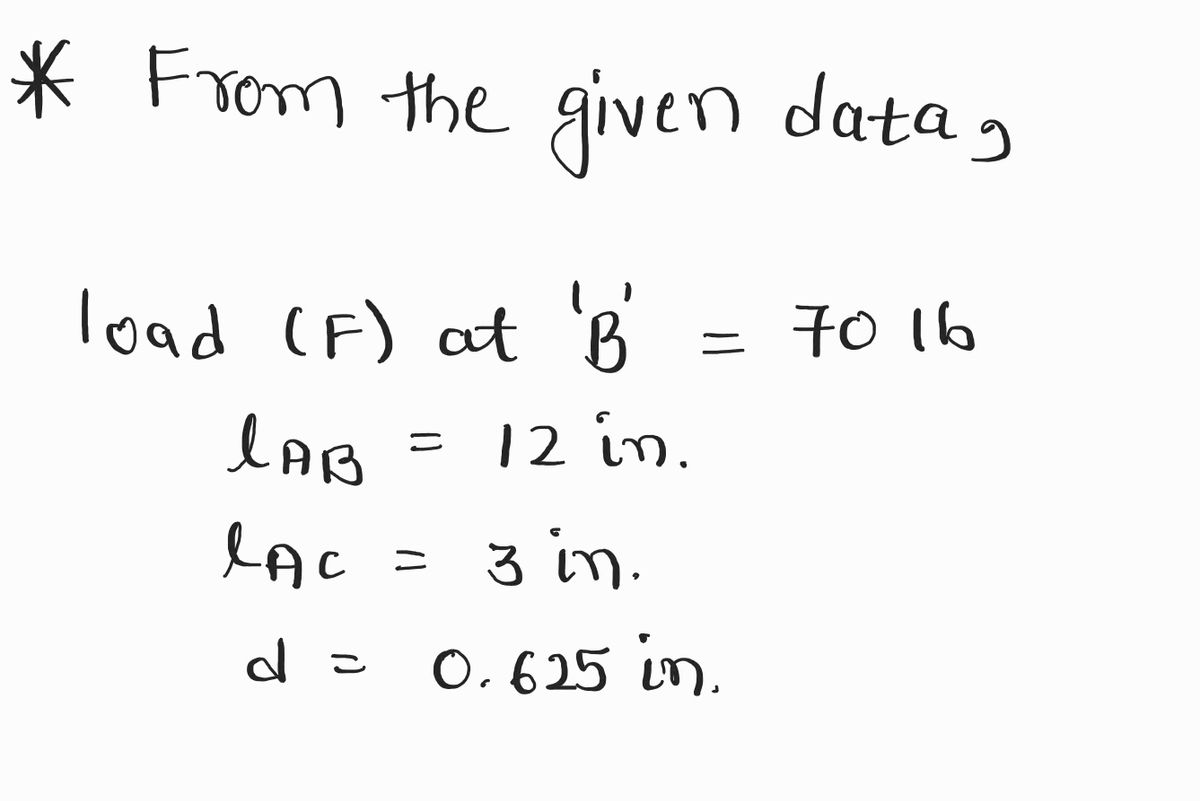Calcuate Bending From Point A to Point B and Point A to Point C also Torsion from Point A to Point C. Draw a FBD from point A to point B and another for point A to C indicating what stresses are been calculate. Use the stress tensor and stress cube to Indicate what forces are acting at point A. Force apply at point B is 70lb Distacen from Point A to B is 12 in or 1 feet long Distacen from Point A to C is 3 in Handle diameter 0.625 in
Calcuate Bending From Point A to Point B and Point A to Point C also Torsion from Point A to Point C. Draw a FBD from point A to point B and another for point A to C indicating what stresses are been calculate. Use the stress tensor and stress cube to Indicate what forces are acting at point A. Force apply at point B is 70lb Distacen from Point A to B is 12 in or 1 feet long Distacen from Point A to C is 3 in Handle diameter 0.625 in
Elements Of Electromagnetics
7th Edition
ISBN:9780190698614
Author:Sadiku, Matthew N. O.
Publisher:Sadiku, Matthew N. O.
ChapterMA: Math Assessment
Section: Chapter Questions
Problem 1.1MA
Related questions
Question
Calcuate Bending From Point A to Point B and Point A to Point C also Torsion from Point A to Point C. Draw a FBD from point A to point B and another for point A to C indicating what stresses are been calculate. Use the stress tensor and stress cube to Indicate what forces are acting at point A.
Force apply at point B is 70lb
Distacen from Point A to B is 12 in or 1 feet long
Distacen from Point A to C is 3 in
Handle diameter 0.625 in

Transcribed Image Text:### How to Use a Lug Wrench
This educational image explains the application of a lug wrench when changing a tire and provides a clear understanding of its mechanics.
#### Diagram Description:
1. **Side View Diagram:**
- **Axle:** The central rod around which the wheel rotates.
- **Lug Wrench:** The tool used for loosening and tightening the lug nuts. It is depicted here in pink and has a handle labeled from point A to point B.
- **Distance Measurement:** The vertical distance from the center of the axle to the lug wrench handle (point B) is marked as 3 inches.
2. **Front View Diagram:**
- **Tire:** The round, black component that makes contact with the road and surrounds the wheel.
- **Lug Wrench Positioning:** The lug wrench is shown inserted into a lug nut on the tire.
- **Force (F):** The downward force applied at point B on the handle of the lug wrench, necessary for turning the lug nut.
The diagram effectively illustrates the principle of leverage used in turning the lug nuts with the lug wrench. By applying force at the end of the wrench (point B), the user generates sufficient torque to loosen or tighten the nuts, facilitating easier tire changes.
Expert Solution
Step 1: Given data
For the solution refer below images.

- Find F.B.D. and shear and bending diagrams for portions AB and BC.
- Find stress tensor at A.
Step by step
Solved in 5 steps with 7 images

Knowledge Booster
Learn more about
Need a deep-dive on the concept behind this application? Look no further. Learn more about this topic, mechanical-engineering and related others by exploring similar questions and additional content below.Recommended textbooks for you

Elements Of Electromagnetics
Mechanical Engineering
ISBN:
9780190698614
Author:
Sadiku, Matthew N. O.
Publisher:
Oxford University Press

Mechanics of Materials (10th Edition)
Mechanical Engineering
ISBN:
9780134319650
Author:
Russell C. Hibbeler
Publisher:
PEARSON

Thermodynamics: An Engineering Approach
Mechanical Engineering
ISBN:
9781259822674
Author:
Yunus A. Cengel Dr., Michael A. Boles
Publisher:
McGraw-Hill Education

Elements Of Electromagnetics
Mechanical Engineering
ISBN:
9780190698614
Author:
Sadiku, Matthew N. O.
Publisher:
Oxford University Press

Mechanics of Materials (10th Edition)
Mechanical Engineering
ISBN:
9780134319650
Author:
Russell C. Hibbeler
Publisher:
PEARSON

Thermodynamics: An Engineering Approach
Mechanical Engineering
ISBN:
9781259822674
Author:
Yunus A. Cengel Dr., Michael A. Boles
Publisher:
McGraw-Hill Education

Control Systems Engineering
Mechanical Engineering
ISBN:
9781118170519
Author:
Norman S. Nise
Publisher:
WILEY

Mechanics of Materials (MindTap Course List)
Mechanical Engineering
ISBN:
9781337093347
Author:
Barry J. Goodno, James M. Gere
Publisher:
Cengage Learning

Engineering Mechanics: Statics
Mechanical Engineering
ISBN:
9781118807330
Author:
James L. Meriam, L. G. Kraige, J. N. Bolton
Publisher:
WILEY